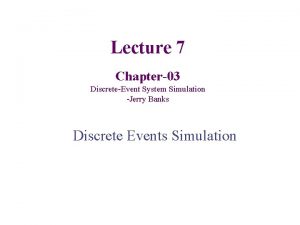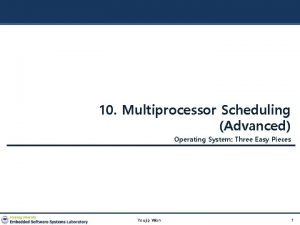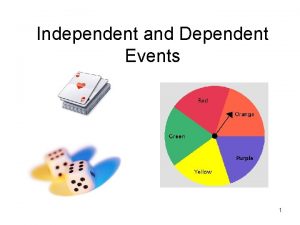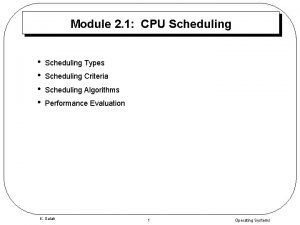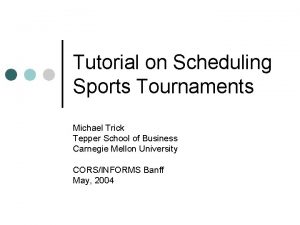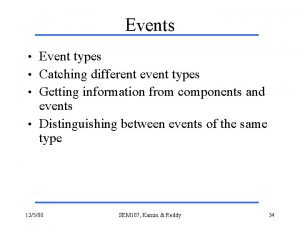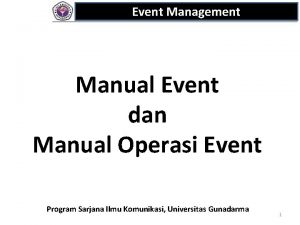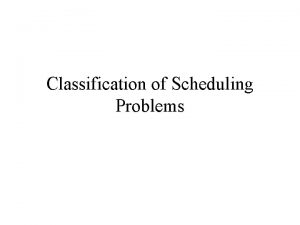Event Management Scheduling Types of Tournaments 1 Single













- Slides: 13

Event Management Scheduling

Types of Tournaments 1. Single Elimination 2. Consolation 3. Double Elimination 4. Round Robin 5. Challenge Tournaments 6. Season

Seeding � Seeding is placing rankings on each entry. The purpose is to prevent highly skilled entries from eliminating one another in the early rounds, in the hopes that the top contenders meet in the final rounds and the top two entries compete for the championship � When seeding 8 entries or less, follow this method: top of the top, bottom of the bottom, top of the bottom, bottom of the top (then reverse if 9 entries or more, up to 16)

Byes � The highest seed(s) in the tournament should receive the bye(s). � When the total number of entries does not work out to an even power of 2 (2, 4, 8, 16, etc) byes must be used. � Take the nearest power of 2 and subtract the number of entries to find out the number of byes needed. �Example: 6 entries 8 – 6 = 2 byes

Which Type Do I Use? �Which type of tournament to set up depends on several factors. �Number of entries �Time allotted for playing the tournament �Facilities available �The advantages and disadvantages of each type of tournament.

Single Elimination �Advantage – quickest method of determining a winner. �Disadvantage – provides the fewest opportunities for contestants to play. �The total number of games to be played can be figured by subtracting 1 from the number of entries. �Example: 16 entries

Single Elimination �To determine the number of rounds, the total should be the same number as the power to which 2 must be raised to equal the number of entries. �Example: For 8 entries, 2 must be raised 3 times (2 X 2 X 2)=8. A tournament with 8 entries would then have 3 rounds.

Consolation Tournament �A consolation tournament may be conducted with losers from the first round of a single elimination tournament. �Allows for every entry to play at least 2 games and follows the same format as a single elimination tournament.

Double Elimination � Advantage – includes a minimum of 2 games for each entry and a shortened game schedule. � Disadvantage – is that participation is reduced by having a limit of 2 losses. � Double elimination tournaments operate in the same manner as a single elimination tournament with one major exception. Entries must lose 2 games to be eliminated. � Once an entry loses it then goes to the losers bracket to continue play. � The teams that win out in both brackets are matched for the Championship. � The max number of games to be played can be figured by the following formula: 2(N-1)+1= �E. g. 16 teams, 2(16 -1)+1= 31 possible games

Double Elimination

Round Robin Tournament �Advantage – provides an equal number of games for all teams. �Disadvantage – it takes a great deal of time to complete if there are several teams competing. �A round robin tournament provides the opportunity for a number of teams in a tournament to play against one another: once (single round robin), twice (double round robin), etc… �To determine the number of rounds to be played, follow this formula: �Odd number of teams = N e. g. 5 teams = 5 rounds �Even number of teams = N-1 e. g. 6 teams: 6 – 1 = 5

Round Robin Tournament �To determine the number of games to be played: �No. of games = N (N-1) e. g. 6 teams, 6 (6 -1) = 15 games 2 2 �To determine the complete schedule, for an even number of entries, leave one team in a constant location and rotate the others counterclockwise. Rounds 1 2 3 4 5 A–F A–E A–D A–C A–B B–E F–D E–C D–B C–F C–D B–C F–B E–F D–E

Round Robin Tournament �For an odd number of entries leave the bye in a constant location and rotate the others Round 1 2 3 4 counterclockwise. 5 s Bye – E Bye – D Bye – C Bye – B Bye – A A–D E–C D–B C–A B–E B–C A–B E–A D–E C–D Teams A D � Wins, losses and Bties can. Cbe recorded on Ea chart. Total like the following: A B C D E Points
 Ladder tournament format of 10 participants
Ladder tournament format of 10 participants Darwinator
Darwinator Job scheduling vs process scheduling
Job scheduling vs process scheduling Dump truck problem in simulation
Dump truck problem in simulation Single queue multiprocessor scheduling
Single queue multiprocessor scheduling Adverse vs sentinel event
Adverse vs sentinel event Simple and compound events
Simple and compound events Independent event vs dependent event
Independent event vs dependent event Independent event vs dependent event
Independent event vs dependent event Example swot analysis for event planning business
Example swot analysis for event planning business Bridge breaks in central java
Bridge breaks in central java Newsworthy event (s); background event (s); sources
Newsworthy event (s); background event (s); sources Schottky barrier rectifier test
Schottky barrier rectifier test Von neumann architecture is sisd
Von neumann architecture is sisd



